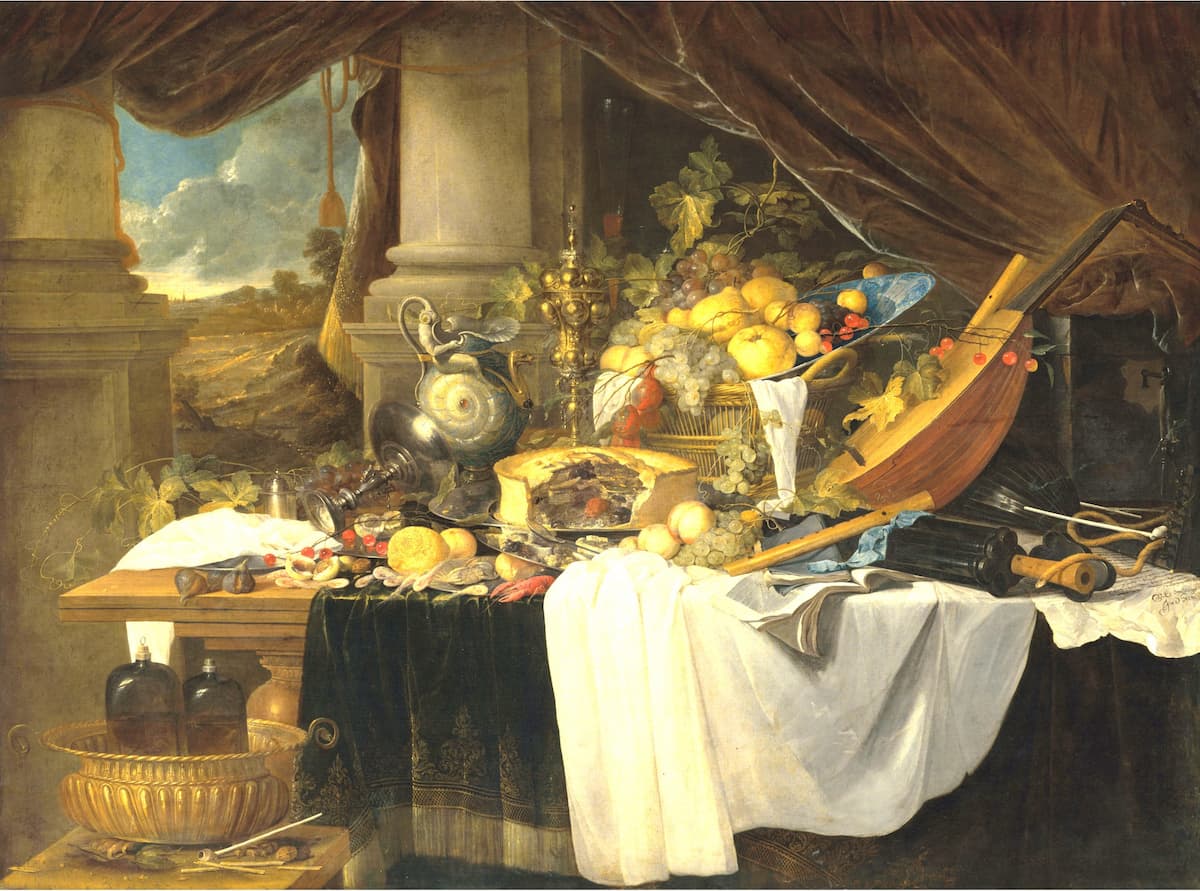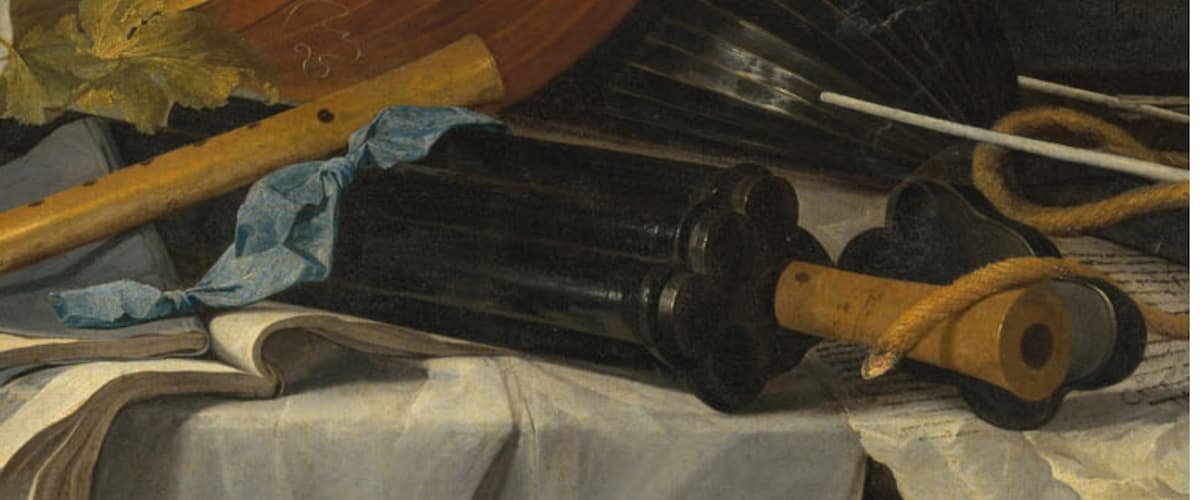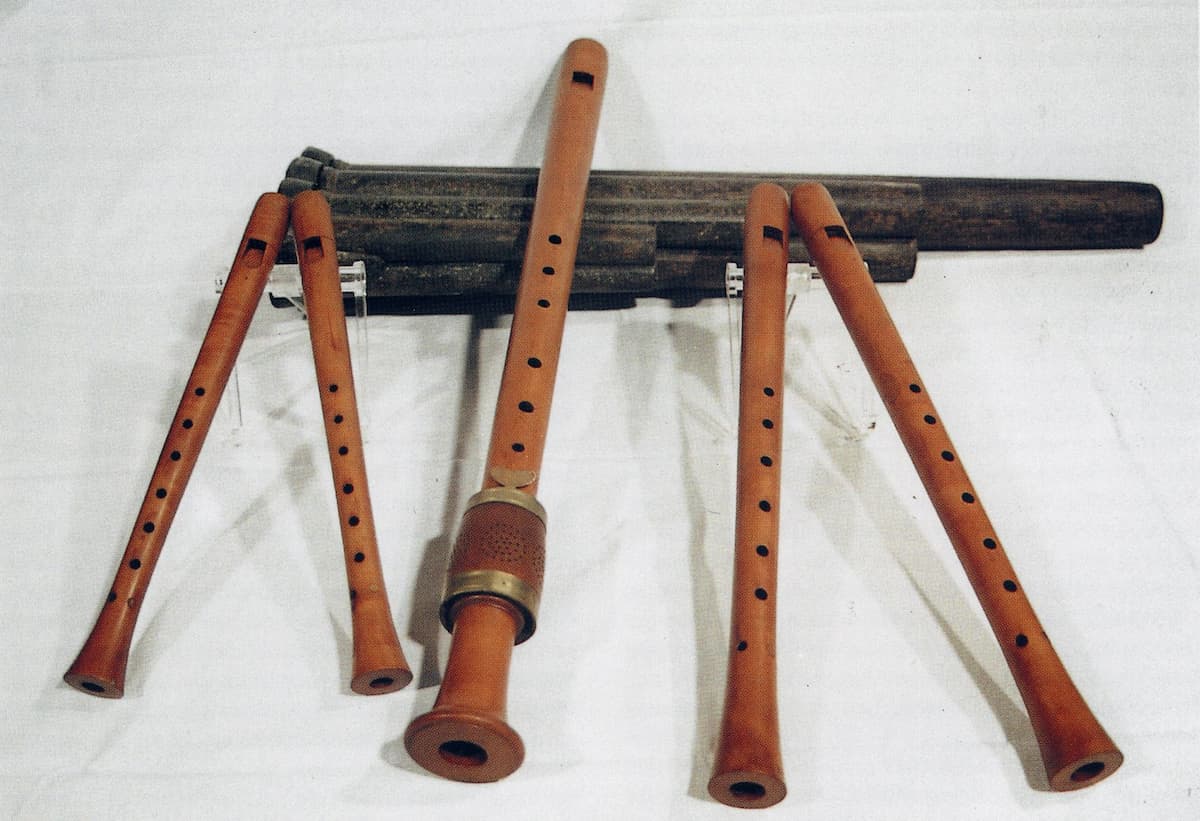Combining Dutch precision with Flemish grandeur, the still-life paintings by Jan Davidz de Heem changed the world of painting. Taking the idea of pronkstileven (sumptuous still-life) as his mantra, de Heem produced pictures of enormous size.
One that has recently been placed in the Fitzwilliam Museum in Cambridge for the next two years is his monumental W 83 X H 61 IN. (211.0 X 155.0 CM) painting A Banquet Still Life. The painting was sold to a private collector in 2020 by Christie’s and has been put on show until 2025 after its recent cleaning.
Luxury starts its definition in this painting.

de Heem: A Banquet Still Life, ca.1640–1643 (private collection, temporary exhibition at Fitzwilliam Museum until 2025)
The description from the 2020 Christie’s auction lays it all out:
A heavily laden banquet table stands in a palatial setting before a terrace flanked by columns. A curtain has been drawn to reveal a landscape with a church spire in the distance. A silver-gilt wine cooler with two bottles stands on a stool in the lower left foreground. The table itself is partially covered by a white cloth which is bunched up over a green velvet cloth with a braided edge. On the banquet table are some pewter plates laden with a variety of fruit, shrimps, a crab, a red-boiled crayfish and a fruit pie. To the right of the pie is a large wicker basket holding a Wanli-kraak porcelain salver, piled with grapes, plums, peaches, cherries, apples and pears, that spill out onto the table. To the left, a silver tazza lies on its side next to a silver sugar shaker and an extraordinary silver-mounted, turbo shell ewer adorned with a large ruby set in the centre. A large silver-gilt columbine cup and cover stands in the middle of the composition with a tall, half-filled flute glass behind. In front and to the right of the basket are a lute and several flutes, as well as a leather flute case lying by a book and an open portfolio. To the right is a smouldering taper and a pipe beneath a strong box with keys in the lock.
What makes it luxurious is not only the vast number of expensive objects but also how they are presented by de Heem. Texture is paramount, from the shine on the turbo-shell ewer to the softness of the velvet being used as a tablecloth. The light on the flute and the back of the dark lute attest to their polish. The scale is also a point made to impress – to have not one but two lutes carelessly piled on the table, with the grapes and cherries spilling out of the bowl to encroach on the instruments gives a sense of ‘effortless grandeur.’
Nicolas Vallet: Secretum musarum: Fortune angloise – Malle sijmen – Slaep, zoete slaep (Harjo Neutkens, lute)
The variety of fruit gives a mixed moral message: cherries are the fruit of paradise, but are paired with the forbidden fruit of peaches and apples. Grapes are a sign of redemption and wine a symbol of the Eucharist. The palace room where the table sits is balanced by the church steeple in the distance. The architecture is massive and looks out onto an even larger seascape.
On the table, as in most still-life paintings, the larger metaphor is about ephemera: food rots, and whatever it is, we can’t take it with us. The fruit pie has been broached, the candle snuffed out, the instruments lie silent, and the fruit and fish will not last very long.
Jan Pieterszoon Sweelinck: Psalm 116, “J’ayme mon dieu” (Jean-Noel Catrice, Francis Mercet, flutes; Arnaud Van de Cauter, organ; Vincent Recolin, cond.)

de Heem: A Banquet Still Life – detail of right side, ca.1640–1643 (private collection, temporary exhibition at Fitzwilliam Museum until 2025)
On the right side are what interests us: 2 lutes and 3 flutes. The yellow-back lute is strung but some of the strings are broken. The black-back lute also has strings that trail off. Between the two instruments is a black case with the bottom of a flute poking out. Behind the flute, you can see the lid of the flute case. Another flute is upside-down behind the yellow-back lute and another lies upside down in front of the same lute.
Jacob van Eyck: Der Fluyten Lust-hof, Book 2: CVIII. Excusemoy (Sébastien Marq, flute; Rolf Lislevand, lute and baroque guitar)

de Heem: A Banquet Still Life – detail of flute case, ca.1640–1643 (private collection, temporary exhibition at Fitzwilliam Museum until 2025)
To see this case as it might have looked, here’s one from Germany.

The Late Renaissance instrument case in Quedlinburg, Germany
What do the lutes and flutes say to us? These musical instruments required the free time to play them – lutes for the accompaniment and flutes for the melodies. The flute case held a family of flutes so that many people at the banquet could join in the musical fun. Music playing was a skill of the educated, of those with leisure time, and of those with an interest in the arts that could be shared with others. Just as much as the silver and shell ewer, the fragility of the lute speaks to it as being designed for a wealthy household.
It’s always interesting looking at these pictures and trying to imagine what message the painter was trying to send: all this is nothing in the harsh light of life and death? Enjoy these while you may? Or even, this is how we used to live in the past?
For more of the best in classical music, sign up for our E-Newsletter




